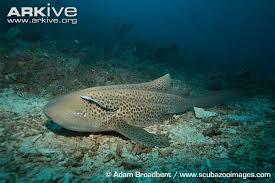Finn Friday: Zebra Shark
- Alyssa Allen

- Feb 26, 2021
- 2 min read
Hello my fellow curious critters and welcome back to another Finn Friday! Today we are going to be learning all about the Zebra shark. I fell in love with these beautiful sharks during my time working at Newport Aquarium. They just look so graceful as they glide through the water. Their name may seem a bit misleading since they have spots, but I will dive into that later on. So throw on your scuba gear and get ready for a little trip to the coral reef to learn all about the Zebra shark.
Where do they live?
Zebra sharks, like me, prefer the tropics. They can be found around the coral reefs of the Western Pacific Ocean, Indian Ocean, and the Red Sea. They can be found at depths of up to around 207 feet (62 meters).

How long do they live?
Zebra sharks can live to be around 25-30 years old. They are oviparous, so they hatch from an egg. When they hatch, zebra sharks can be under 1 foot (30.5 centimeters) in length but will reach lengths of around 12 feet (3.7 meters) as an adult. Females reach maturity at around 6 feet (170 centimeters) in length while males reach maturity at around 5-6 feet (150-180 centimeters) in length.
What do they eat?
Zebra sharks are bottom dwellers, so they love food that also hangs out near the seafloor. Their favorite snacks include mollusks, small bony fish, snails, shrimp, crabs, and even sea snakes! They suck up their food using their powerful buccal cavity, or mouth, muscles.
What do they like to do?
Zebra sharks tend to be more nocturnal in nature, so they spend their days sleeping. They usually love to find a nice spot along the ocean floor with a bit of a current so that water will flow over their gills and they don’t have to work as hard to breathe. In fact, when the current is strong, they have even been observed “surfing”. Zebra sharks surf by adjusting their fins to remain motionless in open water. Once the sun sets, though, they wader around foraging for food and snacking on prey.
Now, let’s talk about how they got their name. As adults, Zebra sharks are covered in spots and look nothing like the striped Zebras that inspired their names, but the same isn’t true for the babies. Juvenile zebra sharks have pale stripes that break up their darker coloration, reminiscent of Zebras. As they age, those stripes break up and turn into the spots seen on adults!
Conservation status:
According to the IUCN Red List, Zebra sharks are endangered and their populations are decreasing. One of the biggest contributors to their decline is the destruction of coral reefs. They are also sometimes targeted by sport fishermen and caught as bycatch. When this happens, their meat and fins are often sold in markets in Asia.
Thank you so much for coming along and learning with me today. I hope you enjoyed learning about the beautiful Zebra shark as much as I did. Do you have a favorite shark species that you want me to cover for our next Finn Friday? Let me know below and I’ll see you all back here soon for more science fun!
Sources:








Comments